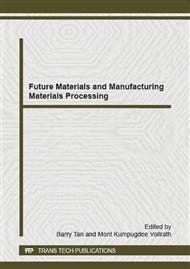p.3
p.9
p.15
p.19
p.25
p.31
p.35
p.39
p.45
Adsorption of Sulfur’s Atoms on the Outer Surface of Carbon Nanotubes
Abstract:
The article is about regularities of structure formation of carbon nanotubes (7,7) in their ground state in the process of the gradually increasing of the concentration of sulfur atoms. The fragment of nanotube is investigated within the framework of the density functional theory with the using of periodic boundary conditions. It contains 112 carbon atoms and n = 1 ÷ 9 sulfur atoms. It is shown that the most energetically favorable configurations of n = 1 ÷ 6 sulfur atoms can be considered as a configuration uncombined sulfur clusters Sn with the slight deformation by tube field. From n = 6, there is a tendency toward the formation of a ribbon structures with 2 sulfur atoms wide, it has a tendency in the moment of increasing n to be guided by transversely to the tube axis. In all considered cases the sulfur atoms are located at a distance from the surface of the tube more than 0.28 nm, it is excluded the possibility of the formation of the strong (covalent) chemical bonds with the carbon nanotube.
Info:
Periodical:
Pages:
25-29
Citation:
Online since:
February 2015
Price:
Сopyright:
© 2015 Trans Tech Publications Ltd. All Rights Reserved
Share:
Citation:


